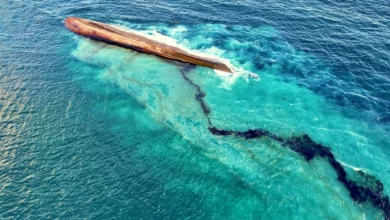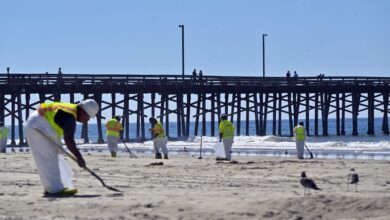New Orleans–The image of thick crude gushing from a blown-out oil well a mile beneath the Gulf of Mexico was turned off when a tightly fitting cap was secured on top a month-and-a-half ago.
Engineers weren't expecting that sight again Thursday when they planned to delicately remove the cap as a prelude to raising the massive piece of equipment underneath that failed to prevent the worst offshore oil spill in US history.
But the government wasn't offering a guarantee no more oil would leak. Plans were being made for oil collection vessels to be on standby in case of a problem.
With the cap and failed blowout preventer removed temporarily until another blowout preventer can be installed, a lot will be riding on the stability of a plug that was created when mud and cement were pumped down into the well from the top. Essentially, the pressure exerted downward served to counter the pressure coming up.
But Rice University engineering professor George Hirasaki said there is still uncertainty about whether the cement settled everywhere it needed to in order to keep oil and gas from finding its way up.
"Just because it didn't flow when they tested it doesn't mean the cement displaced all of the oil and gas," Hirasaki said.
That's why many people have felt that finishing a relief well and pumping mud and cement in through the bottom would be the ultimate solution to the crisis, said Hirasaki, who was involved in the oil containment effort in the Bay Marchand field off Louisiana after a rig burned in the early 1970s.
The government still plans on ordering BP PLC, the majority owner of the blown-out well in the Gulf, to do the so-called bottom kill operation. But it believes the wisest course is to put on a new blowout preventer first to deal with any pressure that is caused when the relief well intersects the blown-out well.
Another potential risk: What happens if the crane attached to the blowout preventer accidentally drops the 50-foot, 300-ton device onto the wellhead?
That might not, in and of itself, cause more oil to spew, as long as the plug held, but it would make it difficult to continue the operation, Hirasaki said.
"It would crush everything," he said. "It would be hard to place another blowout preventer on top of it. Right now the wellhead condition is in good condition. But if you dropped it, everything could be opened up."
Retired Coast Guard Adm. Thad Allen, the government's point person on the oil spill response, told reporters Wednesday during a visit to BP's US offices in Houston that engineers believe the crane will be able to handle the weight of the blowout preventer and some fragile pipe that is believed to be lodged inside.
But if the crane were to swing like a pendulum, that could cause problems, which is why officials have been waiting for rough seas at the site to calm down before continuing with the removal of the blowout preventer. They don't believe the surface conditions will cause problems with removing the cap, which is why they feel comfortable going forward with that around midday Thursday.
After the cap is removed, the Helix Q4000 will latch its hooks onto the blowout preventer and wait for instructions to begin lifting it up. Engineers are prepared to exert a tremendous amount of pressure to get the blowout preventer free, but they must be careful not to damage it because it is a key piece of evidence in ongoing investigations.
Allen said there is no "significant risk" of more oil leaking into the environment. But he said that after the cap and blowout preventer are removed, "The goal there will be to secure the annulus as quick as we can."
The annulus is an area between the inner piping and the outer casing.
Based on an updated timeline Allen released Wednesday, the blowout preventer could begin being raised late Thursday or early Friday, but Allen cautioned that timeline could be stretched again if high seas continue to kick up. The final plugging of the well isn't expected until after Labor Day.
A 12-person government evidence team is waiting to take possession of the blowout preventer when it reaches the surface.
The Deepwater Horizon rig explosion April 20 killed 11 workers and led to 206 million gallons of oil spewing from BP's undersea well.
BP was leasing the rig from owner Transocean Ltd.
Meanwhile, BP PLC said it has spent more than US$5 million a week on advertising since the Gulf oil spill began – more than three times the amount it spent on ads during the same period last year.
BP told the House Energy and Commerce Committee that it spent a total of US$93 million on advertising from April to the end of July. The company says the money was intended to keep Gulf Coast residents informed on issues related to the oil spill and to ensure transparency about its actions. The increased spending was largely targeted at TV, newspapers and magazines. A small portion was directed to the Internet.
BP said it actually aired fewer TV spots from April to July than during a similar period last year.




